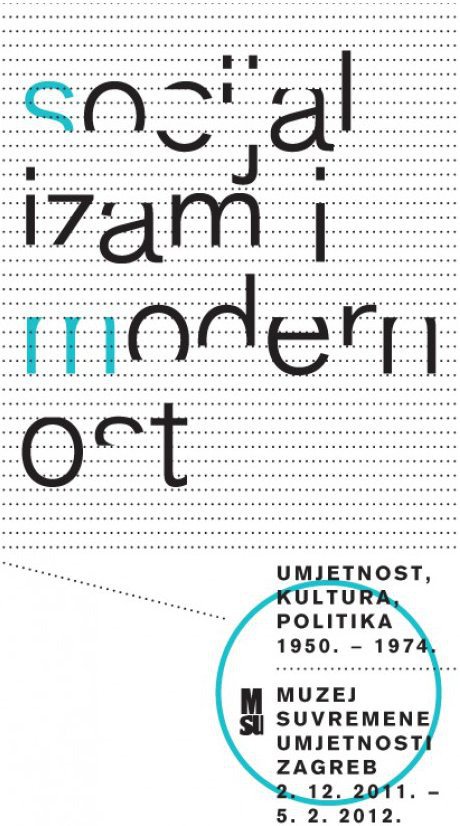Socialism and Modernity
dal 1/12/2011 al 4/2/2012
Segnalato da
Dean Duda
Tvrtko Jakovina
Sandra Krizic Roban
Dejan Krsic
Ljiljana Kolesnik
Vladimir Cajkovac
Petra Srbljinovic
1/12/2011
Socialism and Modernity
Zagreb Museum of Contemporary Art MSU, Zagreb
Art, Culture and Politics 1950 - 1974. Using objects in the museum's collection and from about 30 other private and public collections, the authors stress the regional and international dimension of the Croatian post-war art scene, recalling the openness and cosmopolitan atmosphere of '60s, when Zagreb was probably the most interesting centre of modern art and culture in Central and South-East Europe.

The exhibition has been prepared by a team of authors and curators: Dean Duda, Tvrtko Jakovina, Sandra Križić Roban, and Dejan Kršić, after a concept by Ljiljana Kolešnik.
The coordinators of the project at the MSU are Vladimir Čajkovac, Curator, and Petra Srbljinović, Assistant Curator
The exhibition Socialism and Modernity focuses on art, culture, and politics from the beginning of the 1950s to the mid-‘70s. Through a collection of nearly 300 objects – from artworks to pony bikes, from the first, brilliantly edited and illustrated children’s encyclopaedia published after World War II, to documentary material on neglected and endangered highlights of modern architecture – the authors of the exhibition develop a story of a very important and still controversial episode from our recent past.
Seeking answers to the question of how the global political Cold War setting and the Yugoslav version of socialism influenced the notions of modernity, modern art, architecture, design, and popular culture in Croatia and Yugoslavia, the exhibition investigates what the phrase "to be modern" meant during that period in the cultural and geo-political space of South-East Europe. They also examine the way in which that meaning was built into the local projections of reality, how it was related to the visions of modernity in other European countries and finally, to what extent the specific characteristics of Yugoslav social order have been determined by the trajectories of the modernization process and its relationship with art, culture, and politics.
Using objects in the museum's collection and from about 30 other private and public collections, the authors stress the regional and international dimension of the Croatian post-war art scene, recalling the openness and cosmopolitan atmosphere of '60s, when Zagreb was probably the most interesting centre of modern art and culture in Central and South-East Europe. To justify such a claim, works of art, architecture and design produced by Croatian artists between 1950 and 1974 are brought together with the artwork of artists from other cultural centres of former Yugoslavia and, where this was necessary and possible, with the artwork of artists from other European countries. Almost all of the art objects by foreign artists are in the possession of Croatian museums and are valuable elements of their collections that serve as reminders of a period imbued with exceptional creativity and intense cultural exchange with the rest of the world.
Popular visual culture is included in the second part of the exhibition and on its own terms – as a product of modern urban life, as a type of visual discourse contesting high modernism's elitist culture and as a reference to the social, political and cultural circumstances conditioning the rejection of a modernist system of values at the end of the ‘60s and the beginning of the ‘70s. A new set of social values framing popular culture is additionally documented by fragments of TV documentaries, ads and news reels that simultaneously depict the appearance of consumerism and the emergence of a new social phenomenon - a youth culture that would already by the mid '70s become a true alternative to the official, high culture.
The exhibition will be supplemented by a richly illustrated brochure and a catalogue, and in the course of its duration a series of panel discussions, talks, and lectures will be held at various locations in the Museum of Contemporary Art.
The exhibition Socialism and Modernity will be held at the Museum of Contemporary Art from December 2nd, 2011 to February 5th, 2012. It has been organized as a joint project by the Museum of Contemporary Art and the Institute for Art History and financially supported by the City Office for Culture, Education, and Sports and the Ministry of Culture of the Republic of Croatia.
Architectural display set-up: Studio Dva plus (Ana Dana Beroš, Judita Ljutić, and Damir Ljutić)
Design of the visual identity of the exhibition: Rafaela Dražić
Catalogue publisher: MSU, Zagreb
Head of education programs accompanying the exhibition: Nada Beroš, Senior curator
Press information:
Jadranka Pintarić +(385) 1 6052736 jadranka.pintaric@msu.hr - publicrelations@msu.hr
about the catalogue: executive editor Irena Gessner igessner@hart.hr
Zagreb Museum of Contemporary Art
Av. Dubrovnik 17, 10000 Zagreb
Hours
Tuesday – Sunday:11-19h / Thursday:11-22h 6/7/14
Mondays and on public holidays closed
Admission:
Adults 30 HRK
Students / senior citizens / disabled persons 15 HRK
Group visits (10-30 persons) 20 HRK



